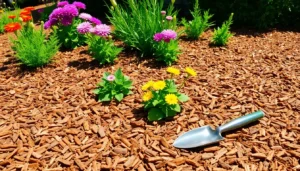Every gardener knows that the right tools can make or break a blooming masterpiece. Imagine trying to dig a hole with a spoon—sounds ridiculous, right? Yet many novice gardeners dive into their green adventures armed with nothing but sheer enthusiasm. The truth is, investing in the right garden tools can turn a patch of dirt into a flourishing oasis, and who wouldn’t want that?
Table of Contents
ToggleOverview of Garden Tools
Garden tools play a pivotal role in gardening success. They simplify tasks, promote efficiency, and enhance the overall gardening experience. Consider essential tools such as shovels, rakes, and pruners. Each serves a unique purpose, making specific tasks easier.
Shovels facilitate digging, planting, and moving soil. They come in various sizes and shapes to suit different needs. Rakes help in leveling soil, gathering leaves, and creating a smooth surface for planting. Pruners maintain plant health by allowing for precise cuts on branches and stems.
Hand tools, including trowels and weeders, are vital for detailed work. Trowels assist with smaller planting tasks, while weeders target unwanted growth. Using these tools minimizes strain and increases precision.
Power tools also support gardening activities. Lawn mowers and tillers save time and reduce physical effort during larger projects. Electric hedge trimmers streamline the maintenance of shrubs and bushes, promoting tidy gardens.
Storage and maintenance are equally important for garden tools. Keeping tools clean and organized prevents rust and prolongs their life. A designated storage area or shed provides easy access and protection from weather.
Investing in high-quality tools pays off in the long run. Durable materials ensure reliability, while ergonomic designs enhance comfort during use. Knowing which tools to choose fosters a more enjoyable gardening experience, leading to vibrant plants and landscapes.
Types of Garden Tools

Garden tools come in several categories, each designed for specific gardening tasks. Understanding these types helps gardeners choose the right tools for their needs.
Hand Tools
Hand tools are essential for detailed and precise gardening tasks. Types of hand tools include trowels for planting, weeding forks for loosening soil, and pruning shears for trimming plants. Using these tools allows for better control and accuracy. They are lightweight and easy to store, making them ideal for small gardens. Hand tools also promote a hands-on approach, fostering a connection with plants and the gardening process.
Power Tools
Power tools enhance efficiency in larger gardens. Common power tools include lawn mowers for cutting grass, tillers for breaking up soil, and leaf blowers for clearing debris. These tools significantly reduce time and physical effort compared to hand tools. They represent an investment worth making for avid gardeners. Using power tools enables quick and effective garden maintenance, allowing more time to enjoy the fruits of labor.
Specialty Tools
Specialty tools cater to unique gardening tasks and needs. Examples include bulb planters for effortlessly planting bulbs, hori-hori knives for digging and cutting, and soil testers for checking soil quality. These tools often feature designs that serve specific functions, boosting productivity. Investing in specialty tools can lead to enhanced gardening outcomes. Utilizing these tools makes tackling particular challenges simpler and more efficient.
Essential Garden Tools for Beginners
Having the right tools makes gardening easier and more enjoyable. Beginners should start with essential hand tools and power tools to effectively maintain their gardens.
Must-Have Hand Tools
Small hand tools form the backbone of any gardener’s toolkit. Trowels serve as essential items for digging holes and transplanting seedlings. Pruning shears enable precise cuts, ensuring plant health and encouraging growth. A cultivator breaks up the soil and helps prepare garden beds. Additionally, a weeder removes unwanted plants without disturbing surrounding soil. Finally, a garden fork aerates compacted earth, improving drainage and nutrient absorption.
Recommended Power Tools
Power tools bring efficiency to larger gardening tasks. Lawn mowers streamline lawn maintenance, ensuring a neat appearance with minimal effort. String trimmers tidy edges and hard-to-reach areas around plants and fences. Garden tillers simplify soil preparation for planting by breaking up dirt and mixing in compost. Hedge trimmers facilitate shaping and maintaining hedges and shrubs, saving time and physical exertion. Finally, leaf blowers assist in keeping garden spaces clean, making fall clean-up more manageable.
Features to Consider When Choosing Garden Tools
Selecting garden tools involves considering various features that enhance usability and efficiency. Focus on material quality and ergonomic design for optimal performance.
Material and Durability
Durable materials play a critical role in the longevity of garden tools. Stainless steel and aluminum resist rust and corrosion, ensuring tools withstand outdoor elements. Additionally, selecting tools with solid construction minimizes the risk of breakage during intense use. Wooden handles or fiberglass add comfort while maintaining strength. Investing in high-quality materials results in tools that remain functional for years, avoiding frequent replacements.
Ergonomics and Comfort
Ergonomic design directly influences gardening comfort. Tools with cushioned grips prevent hand fatigue during extended use. Consider tools with adjustable handles, ensuring a fit that suits different user heights. Lightweight options facilitate ease of maneuverability, especially for those with limited strength. Prioritizing comfort enhances productivity, allowing gardeners to focus on tasks rather than discomfort.
Maintenance Tips for Garden Tools
Maintaining garden tools ensures longevity and optimal performance. Regular care helps gardeners avoid unnecessary costs and enhances their gardening experience.
Cleaning and Storage
Cleaning tools after each use prevents rust and soil buildup. For metal tools, warm soapy water and a stiff brush remove debris effectively. After rinsing, a cloth dries tools thoroughly to protect against moisture. Store tools in a dry, clean area, ideally using pegboards or shelves to keep them organized. Labeling storage spaces can make locating tools easier, preventing mix-ups when digging or planting. Covering tools with protective sleeves or cases helps shield them from dust and dirt.
Repair and Replacement
Regularly inspect tools for signs of wear or damage. Sharpening blades on pruners and shears enhances cutting efficiency, making garden maintenance effortless. Wooden handles may require sanding and oiling to maintain condition. Replace worn-out grips to ensure comfort, especially during long gardening sessions. For irreparable tools, choosing to invest in high-quality replacements saves money in the long run. Opt for durable materials to minimize future repair needs. Keeping track of warranties on new tools can also aid in easier replacements or repairs.
Having the right garden tools is essential for any gardener looking to cultivate a flourishing space. With the right equipment in hand it’s possible to tackle tasks efficiently and effectively. Quality tools not only simplify gardening but also enhance the overall experience.
Regular maintenance and proper storage extend the life of these tools ensuring they remain reliable season after season. By investing in durable materials and ergonomic designs gardeners can work comfortably and productively. Ultimately the right tools pave the way for vibrant plants and a thriving garden.







